DOES SIZE MATTER? - POPULATION PROJECTIONS 20 AND 50 YEARS FROM 2013
CONTENTS
- Introduction
- Continuing the current trend
- Projections for a smaller Australia
- Projections for a bigger Australia
- Net overseas migration and growth
- What happens with zero net overseas migration?
EXPLANATORY INFORMATION
- Endnotes
- Data sources and definitions
Related terms
Population, projections, Big Australia, migration, net overseas migration, future population, age structure, ageing
INTRODUCTION
Periodically there is debate within Australia as to how big or small our population should be in the future. This sparks interest in what is driving growth, and what would happen to the size and structure of Australia's population if these drivers were to change.
The elements of population growth are natural increase (total births minus total deaths) and net overseas migration. The combination of these elements and how they change affects both the size and the age structure of the population. That is, if fertility and net overseas migration were high and life expectancy was low, we could expect a younger nation. If fertility rates were low (for a sustained period of time) and life expectancy increased, we could expect an ageing population. These changes have implications - an ageing population, for example, has a higher total dependency ratio (with more older people potentially economically dependent on fewer people of working age). This poses a future challenge for government policy because the public costs associated with the aged tend to be higher than the costs of people at other ages.1
The total fertility rate in Australia has been rising since 2000 and now stands at 1.9 babies per woman (around half what it was in the early 1960s). Life expectancy is steadily increasing: in the decade to 2012, life expectancy at birth had gone up by 2.5 years for men (to 79.9 years) and 1.7 years for women (to 84.3 years). While it's not easy to effect major population change through fertility and life expectancy over just a few decades, sustained net overseas migration can change the relative size of the working-age population in such a period.
This article uses projections to show what would happen to the size and shape of Australia's population in 20 years time (2033) and 50 years time (2063) if specific assumptions about population growth were to apply. Scenarios include: maintaining recent demographic trends; looking at changes that would lead to a smaller population; and looking at two scenarios that would lead to a bigger population - one where life expectancy, fertility and net overseas migration levels are all high, and one where net overseas migration is a more dominant driver of growth - that is, where net overseas migration levels are high but fertility levels are low and life expectancy does not change from current levels. The article also looks at what would happen to the population in the (highly improbable) event that net overseas migration was zero.
Population pyramids are used to show the extent of each change, overlaying the 2013 estimated resident population with each projected population. Ultimately, the size and shape of our population reflects over 100 years of births, deaths and migration, influenced by major policy and social changes, two world wars, significant improvements in public health, and the advent of widely available, effective contraception. Therefore, regardless of whether higher or lower assumptions are applied to the population over the next 20 and 50 years, much of the impact of these cumulative longer term historical changes will still be visible in the shape and size of the resulting projected populations.
CONTINUING THE CURRENT TREND
In December 2013, the
estimated resident population clocked in at 23.3 million. Around one fifth (19%)
of the population was aged less than 15, while 14% of the population was aged over 65 (including
around
2% aged over 85). The working-age population (aged 15 to 64) was two thirds
of the total population, and there was a total dependency ratio of 50% (that is, there were 50 'dependents' for every 100 'workers', or a ratio of 1:2). Fertility rates were 1.9 births per woman, life expectancy was 79.9 years for men and 84.3 years for women, and
net overseas migration
was averaging 240,000 migrants per year.
If fertility, net overseas migration and life expectancy rates were to continue in line with recent trends (per the medium series projection), the following population pyramid shows what Australia's population would look like in 2033:
Australia in 2033 - continuing the current trend(a)
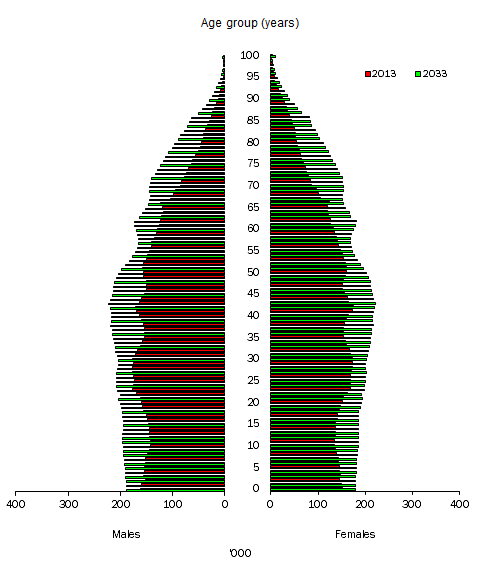 (a) 2013 numbers are estimated resident population at December 2013. 2033 projections reflect Series B of ABS Population Projections (2012 base): a total fertility rate of 1.8 births per woman by 2025-26; life expectancy increasing to reach 85.2 years for men and 88.3 years for women by 2061; and net overseas migration of 240,000.
Source: Australian Demographic Statistics, Dec 2013 (cat. no. 3101.0); and Population Projections, Australia, 2012 (base) to 2101, (cat. no. 3222.0)
(a) 2013 numbers are estimated resident population at December 2013. 2033 projections reflect Series B of ABS Population Projections (2012 base): a total fertility rate of 1.8 births per woman by 2025-26; life expectancy increasing to reach 85.2 years for men and 88.3 years for women by 2061; and net overseas migration of 240,000.
Source: Australian Demographic Statistics, Dec 2013 (cat. no. 3101.0); and Population Projections, Australia, 2012 (base) to 2101, (cat. no. 3222.0)
Under this scenario, the population would be 31 million in 2033. The proportion of people aged 65 years and over would increase
to 19% (from 14%), and the proportion of children (under 15) would decrease slightly
to 18%. The working age population would decrease to 63% of the population, and there would be 59 'dependents' for every 100 'workers'.
The proportion of people aged 85 and over would increase to 3%.
Fast forward another 30 years to 2063, and the population would have reached
42 million. The proportion of people aged 65 and over
would be
23%, while 17% would be aged under 15. The working age population would decrease to 61% of the population, and the dependency ratio would be 65% (65 'dependents' for every 100 'workers'). The proportion of people aged 85 and over would more than double from its 2013 level to 5%.
Australia in 2063 - continuing the current trend(a)
 (a) 2013 numbers are estimated resident population at December 2013. 2063 projections reflect Series B of ABS Population Projections (2012 base): a total fertility rate of 1.8 births per woman by 2025-26; life expectancy increasing to reach 85.2 years for men and 88.3 years for women by 2061; and net overseas migration of 240,000.
Source: Australian Demographic Statistics, Dec 2013 (cat. no. 3101.0); and Population Projections, Australia, 2012 (base) to 2101, (cat. no. 3222.0)
(a) 2013 numbers are estimated resident population at December 2013. 2063 projections reflect Series B of ABS Population Projections (2012 base): a total fertility rate of 1.8 births per woman by 2025-26; life expectancy increasing to reach 85.2 years for men and 88.3 years for women by 2061; and net overseas migration of 240,000.
Source: Australian Demographic Statistics, Dec 2013 (cat. no. 3101.0); and Population Projections, Australia, 2012 (base) to 2101, (cat. no. 3222.0)
PROJECTIONS FOR A SMALLER AUSTRALIA
Lower birth rates, the same life expectancy, and sustained lower net overseas migration intake over the next few decades would result in a smaller population than current trends are suggesting. Based on these lower growth rates,
Australia's population would be 30 million in 2033, 1 million less than the 2013 medium series projection for the same year. One fifth
(20%) of the population would be over 65, with 3% being 85 and over and 16% of people would be under 15. With just under two thirds
of the population being of working age (64%), there would be 57 'dependents' for every 100 'workers'.
Projections for a smaller Australia, 2033 (a)
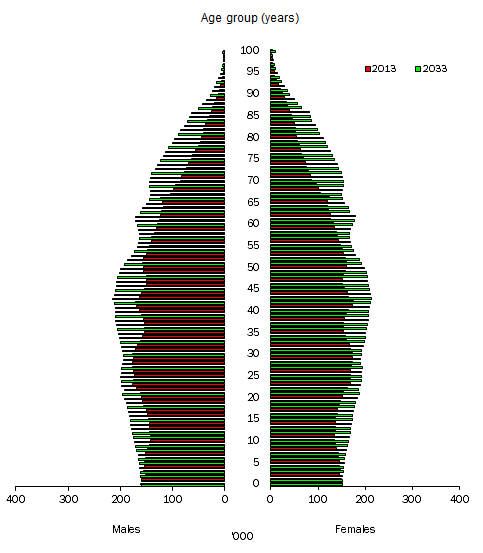 (a) 2013 numbers are estimated resident population at December 2013. Projections for 2033 assume a total fertility rate of 1.6 births per woman by 2025-26; life expectancy increasing to reach 85.2 years for men and 88.3 years for women by 2061; and net overseas migration of 200,000.
Source: Australian Demographic Statistics, Dec 2013 (cat. no. 3101.0); and Population Projections, Australia, 2012 (base) to 2101, (cat. no. 3222.0)
(a) 2013 numbers are estimated resident population at December 2013. Projections for 2033 assume a total fertility rate of 1.6 births per woman by 2025-26; life expectancy increasing to reach 85.2 years for men and 88.3 years for women by 2061; and net overseas migration of 200,000.
Source: Australian Demographic Statistics, Dec 2013 (cat. no. 3101.0); and Population Projections, Australia, 2012 (base) to 2101, (cat. no. 3222.0)
Fast forward another 30 years to 2063 and the population would have increased to 37 million, 5 million less than the 2013 medium series projection for the same year.
The effects of population ageing would be
more evident under this scenario, with the proportion of people aged 65 and over in Australia increasing to 25%, and the proportion of children under 15 decreasing to 15%. The working-age population would decrease to 60% and there would be 66 'dependents' for every 100 'workers'. Under this scenario, 5% of Australians would be 85 years or over.
Projections for a smaller Australia, 2063 (a)
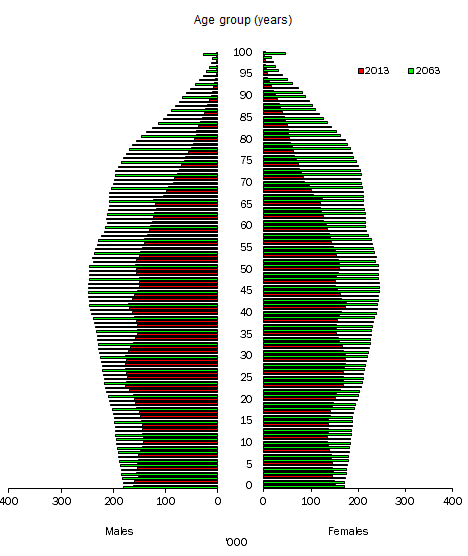 (a) 2013 numbers are estimated resident population at December 2013. Projections for 2063 assume a total fertility rate of 1.6 births per woman by 2025-26; life expectancy increasing to reach 85.2 years for men and 88.3 years for women by 2061; and net overseas migration of 200,000.
Source: Australian Demographic Statistics, Dec 2013 (cat. no. 3101.0); and Population Projections, Australia, 2012 (base) to 2101, (cat. no. 3222.0)
(a) 2013 numbers are estimated resident population at December 2013. Projections for 2063 assume a total fertility rate of 1.6 births per woman by 2025-26; life expectancy increasing to reach 85.2 years for men and 88.3 years for women by 2061; and net overseas migration of 200,000.
Source: Australian Demographic Statistics, Dec 2013 (cat. no. 3101.0); and Population Projections, Australia, 2012 (base) to 2101, (cat. no. 3222.0)
PROJECTIONS FOR A BIGGER AUSTRALIA
High birth rates, high life expectancy and high net overseas migration over the next few decades would result in a bigger Australia (with increased needs for amenities such as housing and infrastructure). While this scenario has more people of working age, it also has more children and older people so the overall dependency ratio increases.
Under the demographic trends which would lead to
a bigger Australia, the total population would be 33 million in 2033 (2 million more people than the 2013 medium series projection for the same year). The proportion of people aged 65 and over would grow to 19%, and the proportion of people aged less than 15 would remain at 19%. The working-age population would fall to 62%, and the dependency ratio would be 61%. The proportion of people aged 85 and over would increase to 3%.
Projections for a bigger Australia, 2033 (a)
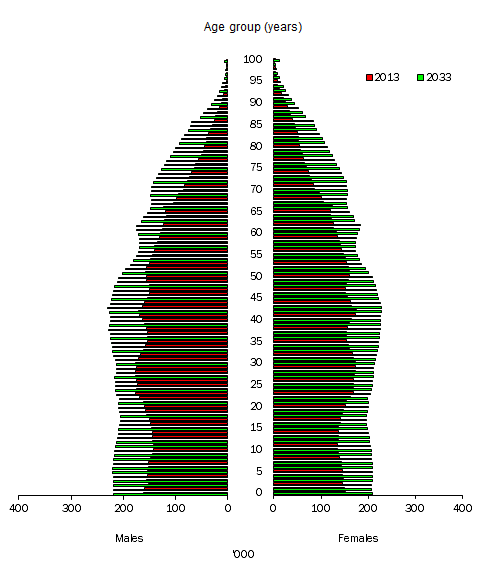 (a) 2013 numbers are estimated resident population at December 2013. Projections for 2033 use the following assumptions; a total fertility rate of 2.0 births per woman by 2025-26; life expectancy increasing to reach 92.1 years for men and 93.6 years for women by 2061; and net overseas migration of 280,000.
Source: Australian Demographic Statistics, Dec 2013 (cat. no. 3101.0); and Population Projections, Australia, 2012 (base) to 2101, (cat. no. 3222.0)
(a) 2013 numbers are estimated resident population at December 2013. Projections for 2033 use the following assumptions; a total fertility rate of 2.0 births per woman by 2025-26; life expectancy increasing to reach 92.1 years for men and 93.6 years for women by 2061; and net overseas migration of 280,000.
Source: Australian Demographic Statistics, Dec 2013 (cat. no. 3101.0); and Population Projections, Australia, 2012 (base) to 2101, (cat. no. 3222.0)
30 years on, in 2063, the total population would be 49 million, 6 million greater than the 2013 medium series projection for the same year. The proportion of people aged 65 and over would be 23%, although the proportion of those aged less than 15 would have decreased to 18%. The working-age population would drop to 59%, and there would be 70
'dependents' for every 100 'workers'. Under this scenario, 6% of Australians would be
aged 85 years and over.
Projections for a bigger Australia, 2063 (a)
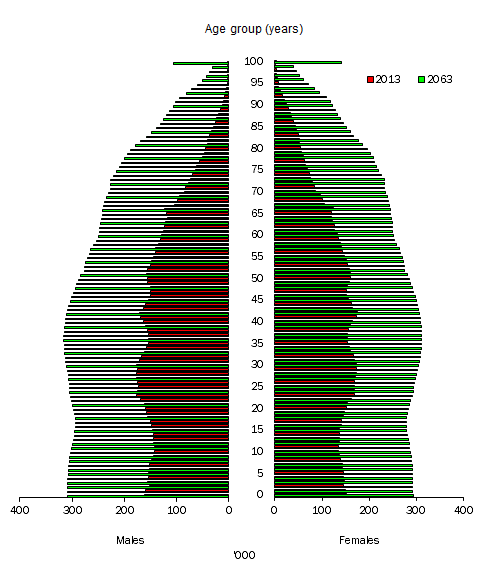 (a) 2013 numbers are estimated resident population at December 2013. Projections for 2063 use the following assumptions; a total fertility rate of 2.0 births per woman by 2025-26; life expectancy increasing to reach 92.1 years for men and 93.6 years for women by 2061; and net overseas migration of 280,000.
Source: Australian Demographic Statistics, Dec 2013 (cat. no. 3101.0); and Population Projections, Australia, 2012 (base) to 2101, (cat. no. 3222.0)
(a) 2013 numbers are estimated resident population at December 2013. Projections for 2063 use the following assumptions; a total fertility rate of 2.0 births per woman by 2025-26; life expectancy increasing to reach 92.1 years for men and 93.6 years for women by 2061; and net overseas migration of 280,000.
Source: Australian Demographic Statistics, Dec 2013 (cat. no. 3101.0); and Population Projections, Australia, 2012 (base) to 2101, (cat. no. 3222.0)
NET OVERSEAS MIGRATION AND GROWTH
In recent years, net overseas migration has become the major driver of Australia's population growth, contributing 60% of total population growth in 2013. The effects of an ageing population may be reduced in the short term with higher levels of working-age people migrating to the country. However,
while immigrants are often at a younger working age when they migrate to Australia, they also age and contribute to the growth of the older population.
2 So what would happen to the size and shape of Australia over time if net overseas migration was higher than current trends but birth rates were low and life expectancy did not change from current levels?
Under this scenario,
Australia's population would be 32 million in 2033. Around 19% of the population would be over 65 (with 3% being 85 and over), and 17% of people would be under 15. Two thirds
of the population would be working age (64%), and there would be 55 'dependents' for every 100 'workers', 4 less than if we were to maintain current trends.
Projections using net overseas migration as the key growth driver, 2033 (a)
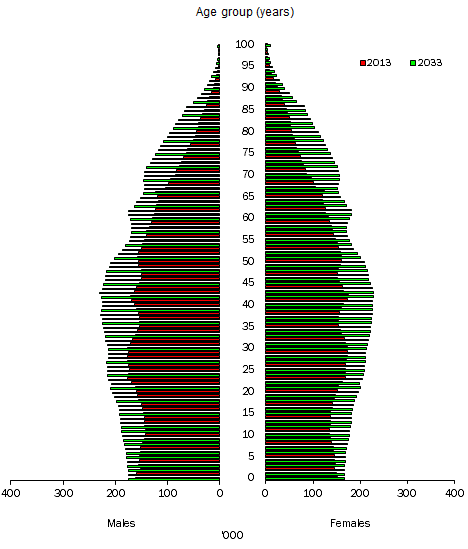 (a) 2013 numbers are estimated resident population at December 2013. Projections for 2033 assume a total fertility rate of 1.6 births per woman by 2025-26; life expectancy increasing to reach 85.2 years for men and 88.3 years for women by 2061; and net overseas migration of 280,000.
Source: Australian Demographic Statistics, Dec 2013 (cat. no. 3101.0); and Population Projections, Australia, 2012 (base) to 2101, (cat. no. 3222.0)
(a) 2013 numbers are estimated resident population at December 2013. Projections for 2033 assume a total fertility rate of 1.6 births per woman by 2025-26; life expectancy increasing to reach 85.2 years for men and 88.3 years for women by 2061; and net overseas migration of 280,000.
Source: Australian Demographic Statistics, Dec 2013 (cat. no. 3101.0); and Population Projections, Australia, 2012 (base) to 2101, (cat. no. 3222.0)
After another 30 years, the total population would increase to 42 million. In 2063, around 23% of the population would be aged 65 and over (with 5% being 85 and over), while those aged under 15 would make up 15%. Three in five people would be of working age (61%), and there would be 63
'dependents' for every 100 'workers' - 2 less than if we were to maintain current trends. Aside from a larger proportion of working age people in 2063 to support those who were not of working age, this population structure is fairly similar to the 2013 medium series projections for the same year, but would result in a larger aged population at a future date.
Projections using net overseas migration as the key growth driver, 2063 (a)
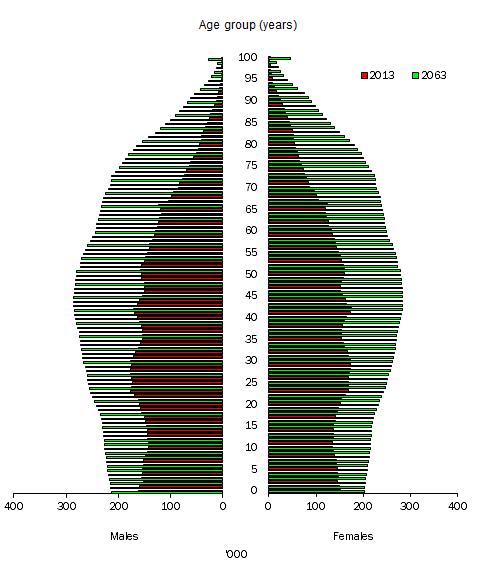 (a) 2013 numbers are estimated resident population at December 2013. Projections for 2063 assume a total fertility rate of 1.6 births per woman by 2025-26; life expectancy increasing to reach 85.2 years for men and 88.3 years for women by 2061; and net overseas migration of 280,000.
Source: Australian Demographic Statistics, Dec 2013 (cat. no. 3101.0); and Population Projections, Australia, 2012 (base) to 2101, (cat. no. 3222.0)
(a) 2013 numbers are estimated resident population at December 2013. Projections for 2063 assume a total fertility rate of 1.6 births per woman by 2025-26; life expectancy increasing to reach 85.2 years for men and 88.3 years for women by 2061; and net overseas migration of 280,000.
Source: Australian Demographic Statistics, Dec 2013 (cat. no. 3101.0); and Population Projections, Australia, 2012 (base) to 2101, (cat. no. 3222.0)
WHAT HAPPENS WITH ZERO NET OVERSEAS MIGRATION?
With zero net overseas migration, that is, the same number of people leaving the country as arriving in it, Australia's total population would depend solely on natural increase. Under this scenario, the total population would be 25 million in 2033, 6 million less than the 2013 medium series projection for the same year. The proportion of people aged over 65 would increase to 23%, and the proportion of those under 15 would decrease to 16%.
Zero net overseas migration would result in people of working age making up 61% of the population in 2033, while the total dependency ratio would increase to 65 'dependents' for every 100 'workers'. At the same time, increasing life expectancy would result in the proportion of people aged 85 or more doubling to 4%.
Australia's population with zero net overseas migration, 2033 (a)
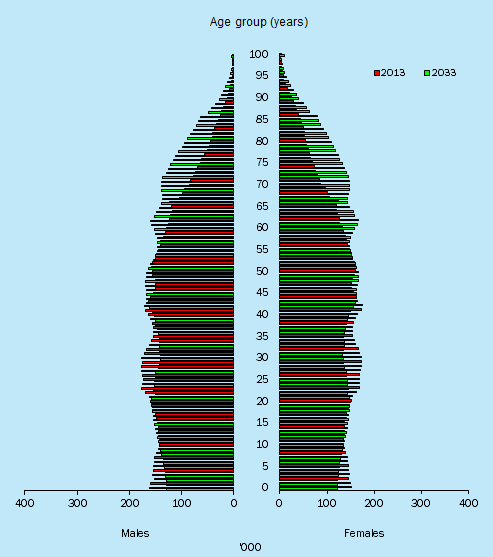 (a) 2013 numbers are estimated resident population at December 2013. Projections for 2063 assume a total fertility rate of 1.8 births per woman by 2025-26; life expectancy increasing to reach 85.2 years for men and 88.3 years for women by 2061; and net overseas migration of 0.
Source: Australian Demographic Statistics, Dec 2013 (cat. no. 3101.0); and Population Projections, Australia, 2012 (base) to 2101, (cat. no. 3222.0)
(a) 2013 numbers are estimated resident population at December 2013. Projections for 2063 assume a total fertility rate of 1.8 births per woman by 2025-26; life expectancy increasing to reach 85.2 years for men and 88.3 years for women by 2061; and net overseas migration of 0.
Source: Australian Demographic Statistics, Dec 2013 (cat. no. 3101.0); and Population Projections, Australia, 2012 (base) to 2101, (cat. no. 3222.0)
With zero net overseas migration, the population would start to decline in 2041 and the effect on Australia's age structure would be very evident. By 2063, the total population would have fallen back to 24 million people - 1 million less than in 2033. The proportion of people aged 65 years and over would increase to 29%, while the proportion of children would be 15%. Working-age people would make up 56% of the population, and there would be 79 'dependents' for every 100 'workers' - a ratio of 4:5. Around 1 in every 13 people (7%) would be aged 85 years or over.
Australia's population with zero net overseas migration, 2063 (a)
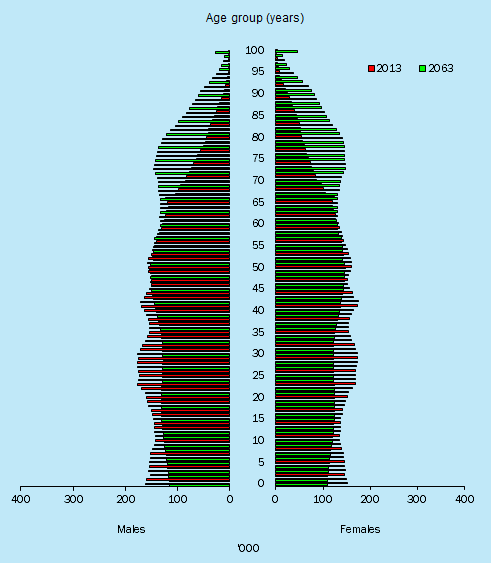 (a) 2013 numbers are estimated resident population at December 2013. Projections for 2063 assume a total fertility rate of 1.8 births per woman by 2025-26; life expectancy increasing to reach 85.2 years for men and 88.3 years for women by 2061; and net overseas migration of 0.
Source: Australian Demographic Statistics, Dec 2013 (cat. no. 3101.0); and Population Projections, Australia, 2012 (base) to 2101, (cat. no. 3222.0)
(a) 2013 numbers are estimated resident population at December 2013. Projections for 2063 assume a total fertility rate of 1.8 births per woman by 2025-26; life expectancy increasing to reach 85.2 years for men and 88.3 years for women by 2061; and net overseas migration of 0.
Source: Australian Demographic Statistics, Dec 2013 (cat. no. 3101.0); and Population Projections, Australia, 2012 (base) to 2101, (cat. no. 3222.0) |
END NOTES
-
- McDonald, P. and Temple, J. The Long Term Effects of Ageing and Immigration upon Labour Supply and Per Capita Gross Domestic Product: Australia 2012-2062, 2013, <www.demographicinsight.com.au>, Last accessed 26/6/2014
- Department of the Environment, 2013 Sustainable Australia Report 2013, Conversations with the Future, <www.environment.gov.au>, Last accessed 26/6/2013
DATA SOURCES AND DEFINITIONS
Population projections
The 2013 publication Population Projections, Australia, 2012 (Base) to 2101 (cat. no. 3222.0), shows a range of population projections to 2101 based on current trends and different combinations of assumptions about births, deaths and net overseas migration rates. These projections are not predictions or forecasts. They show what would happen to Australia's population if a particular set of assumptions about future levels of fertility, mortality, and net overseas migration were to hold for the next 100 years. The assumptions are based on demographic trends, current debate, and possible future scenarios arising from research in Australia and elsewhere.
Projection methodology
This article uses the cohort-component method for producing population projections. In this method, assumptions made about future levels of fertility, mortality, overseas migration and internal migration are applied to a base population (split by sex and single year of age) to obtain a projected population for the following year. The assumptions are then applied to this new (projected) population to obtain a projected population for the next year. This process is repeated until the end of the projection period is reached. From a base of 30 June 2012, the projections span the period 30 June 2013 to 30 June 2063 for Australia. Further details of projection assumptions and methodology can be found in cat. no. 3222.0.
Net overseas migration is the net gain or loss of population through immigration to Australia, and emigration from Australia. Under the current method for estimating final net overseas migration this term is based on a traveller's actual duration of stay or absence using the '12/16 month rule'. Under the '12/16 month rule', incoming overseas travellers (who are not currently counted in the population) must be resident in Australia for a total period of 12 months or more during the 16 month follow-up period to be included in the estimated resident population. Travellers departing Australia (who are currently counted in the population) must be absent from Australia for a total of 12 months or more during the 16 month follow-up period to be subtracted from the estimated resident population. The 12/16 rule takes account of people who may have left Australia briefly and returned, while still being resident for 12 months out of 16. Similarly, it takes account of Australians who live most of the time overseas but periodically return to Australia for short periods.
The total dependency ratio is a measure used to compare the size of the dependent population to the working age population. It is calculated by combining the youth population (0 to 14 years) and senior population (65 and over), then dividing this by the working-age population (15 to 64 years) and multiplying it by 100. It is expressed as the number of 'dependents' for every 100 'workers'. While the ratio may over-simplify the implication of 'dependency' - for example, many people aged 15 to 64 are not part of the workforce, while people aged 65 or over may be working, or self-funded retirees - it provides another broad measure of the structure of the population.
The total fertility rate (TFR) is the sum of age-specific fertility rates (live births at each age of mother per 1,000 of the female population of that age) divided by 1,000. It represents the number of children a woman would bear during her lifetime if she experienced current age-specific fertility rates at each stage of her reproductive life (ages 15-49).
In this article, 'life expectancy' refers to life expectancy at birth, which refers to the average number of years a person might expect to live if the age-specific death rates of the given period continued throughout his or her lifetime.
Estimated resident population (ERP) The official measure of the population of Australia is based on the concept of usual residence. It refers to all people, regardless of nationality, citizenship or legal status, who usually live in Australia, with the exception of foreign diplomatic personnel and their families. It includes usual residents who are overseas for less than 12 months over a 16 month period. It excludes overseas visitors who are in Australia for less than 12 months over a 16 month period. Estimates of the Australian resident population are generated on a quarterly basis by adding natural increase (the excess of births over deaths) and net overseas migration (NOM) occurring during the period to the population at the beginning of each period. This is known as the cohort component method.
|
 Print Page
Print Page
 Print All
Print All